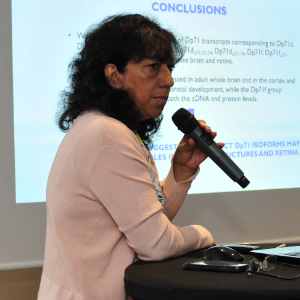Title : Dystrophin Dp71 isoforms are differentially expressed in the mouse retina and brain structures
Abstract:
Cognitive impairment and retinal abnormalities have been reported in the X-linked Duchenne muscular dystrophy. The intellectual disabilities are associated with mutations in the shortest dystrophins Dp71 and Dp40. Molecular, cellular, physiological and behavioral alterations are related with the loss of Dp71 in the brain and retina, supporting a major role for this protein in Central Nervous System (CNS). Dp71 is expressed from a promoter located in intron 62 of the DMD gene, being the most abundant product of this gene in the CNS. The Dp71 mRNA undergoes alternative splicing events in the exons 71, 71-74, 78 and intron 77, generating several isoforms of this protein that are expressed in different tissues including the brain. Three main groups of Dp71 proteins are defined based on their C-terminal specificities: Dp71d, Dp71f, and Dp71e; however, their function is unknown.The aim of this work is to identify the dystrophin Dp71 isoforms expressed in the retina and in specific brain structures and steps during brain postnatal development. For this, total RNA was isolated from adult mice C57BL/6 brain, cortex and cerebellum of mice 1, 7, 14 and 21 days old and retina. RT-PCR assays were carried out and the PCR products were cloned. These products were analyzed by multiplex PCR assay to determine the presence or absence of the exons 71, 71-74 and 78. The Dp71 isoform cDNAs were sequenced and their expression frequency was determined. Up to now, the results show that brain and retina express Dp71d, Dp71d?71, Dp71d?71-74, Dp71f, Dp71f?71, Dp71f?71-74 and Dp40, at different frequencies. Additionally, new alternative splicing for Dp71 mRNA products were found: Dp71d?74, Dp71d?71,74, Dp71d?71,73-74 and Dp71f?74 [1]. Further, a differential expression of Dp71d and Dp71f isoform groups, at protein level, was also observed in the brain and retina. The analysis of Dp71 isoforms in the brain structures demonstrated that the Dp71d, Dp71d?71, Dp71d?71-74, Dp71f, Dp71f?71 and Dp71f?71-74 isoforms are expressed at different frequencies in the cortex and cerebellum at postnatal and adult stages. The Dp71d?74 and Dp71f?74 were observed at late postnatal and adult stages in the cortex, while Dp71d?74 mRNA was found in the cerebellum since early postnatal stages. In conclusion, we demonstrated the expression of Dp71d, Dp71d?71, Dp71d?74, Dp71d?71,74, Dp71d?71,73-74, Dp71d?71-74, Dp71f, Dp71f?71, Dp71f?74 and Dp71fΔ71-74 transcriptsin the mouse brain and retina. The Dp71d group of isoforms is highly expressed in adult whole brain and in the cortex and cerebellum during the brain postnatal development, while the Dp71f group predominates in the retina




